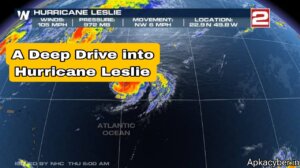
Hurricane Leslie: A Comprehensive Overview
Hurricane Leslie made headlines in 2018 as one of the most notable storms of the Atlantic hurricane season. This article provides an in-depth look at the storm’s formation, trajectory, impacts, and lessons learned from this significant weather event.
Formation and Path of Hurricane Leslie
Hurricane Leslie formed on September 23, 2018, as a tropical storm in the central Atlantic. Its development was influenced by warm sea surface temperatures and favorable atmospheric conditions. Over the next few days, Leslie intensified into a hurricane, reaching its peak strength with sustained winds of 100 mph (155 km/h) on October 1.
Leslie’s path was unusual for a hurricane. It initially moved toward the northwest but later took a looping trajectory that kept it over the Atlantic longer than most storms. This erratic path raised concerns about its potential impact on land, particularly in the Azores, where the storm eventually made landfall.
Impact on the Azores
On October 13, 2018, Hurricane Leslie made landfall in the Azores, a group of Portuguese islands in the mid-Atlantic. The storm brought heavy rain, strong winds, and significant wave activity, resulting in widespread damage. Trees were uprooted, power outages were reported, and transportation was severely disrupted.
The islands faced the brunt of Leslie’s wrath, with the most affected areas experiencing flooding and landslides. Fortunately, the region’s preparedness and response mechanisms minimized casualties, but the economic impact was substantial. Recovery efforts began immediately, focusing on restoring power and repairing damaged infrastructure.
Preparing for Future Storms
Hurricane Leslie serves as a reminder of the unpredictability of hurricanes and the importance of preparation. Residents in vulnerable areas must remain informed about storm forecasts and develop comprehensive emergency plans. Key measures include:
- Staying Informed: Regularly monitor weather updates from reliable sources such as the National Hurricane Center.
- Emergency Kits: Prepare an emergency kit with essentials like food, water, medications, and important documents.
- Evacuation Plans: Have a clear evacuation plan that includes routes and destinations.
- Community Awareness: Engage with local communities to promote awareness and preparedness.
The Role of Climate Change
While it’s challenging to directly attribute individual storms to climate change, scientists agree that warmer ocean temperatures can lead to more intense hurricanes. As global temperatures rise, the potential for stronger and more erratic storms like Hurricane Leslie may increase. This emphasizes the need for continued research and investment in climate resilience strategies.
Conclusion
Hurricane Leslie is a crucial case study in understanding hurricane behavior and impact. Its unusual path and significant effects on the Azores highlight the necessity for preparedness and adaptive strategies in the face of changing climate patterns. By learning from events like Hurricane Leslie, communities can better protect themselves against future storms, ensuring resilience in the face of nature’s fury.